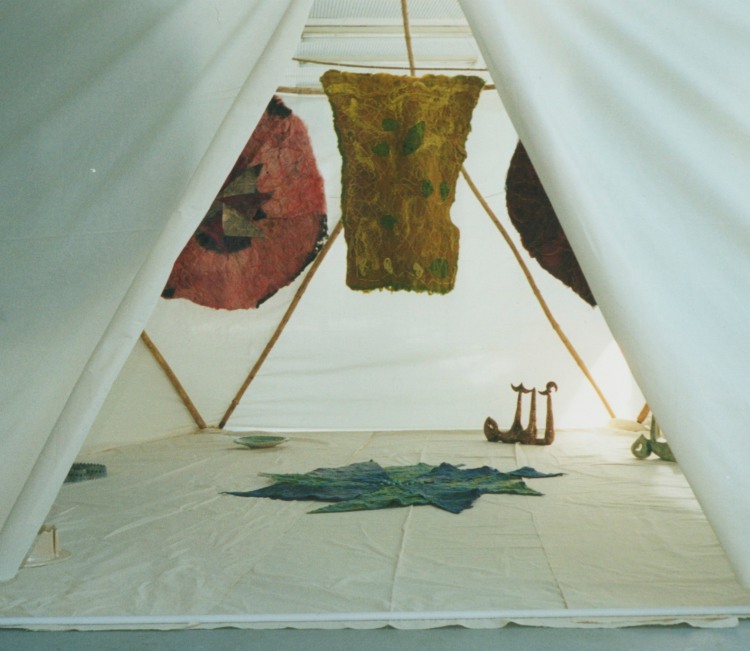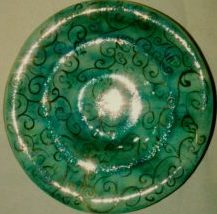I have just completed my 4th draft proposal for a practice-led PhD and having been advised to show them to other people wondered if anyone had any useful criticisms ?
Arranging things -4th draft word
PS – what I am talking about includes stuff like this :



I await any responses ……

I am not sure what you want here…I am not familiar with college application proposals…especially, having never done one before. However, if you want a critique…I might be able to do some of that. I love the “Prayer Times in Turquoise”. The colors are beautiful and spiritual. The points are consistent in concept and in design. My only critique would be to add deeper dimensions to the squares and stars, thereby creating more drama and power. I would need to go in and walk around your exhibit to say something about it. And your felt hanging with the earthen stones is very noteworthy. Is that Arabic writing on it? What does it say?
LikeLike
I’ll think about it.
LikeLike
Hi Kathy – yes I was just putting in the pieces as illustrations of what I talk about in the proposal . Of course I will take my portfolio on the laptop if I have an interview so would probably explain myself using these examples also . I would agree with your critique of the turquoise thing – it ended up like that because it was a collage of already existing sketches and designs which is , of course , much more limiting than a drawing or painting from scratch . The thing is that limits really stimulate me .
The writing is in Arabic and spells out ‘Allah’ which means ‘(the) god’ . Arabic has no upper case or indefinite article so importance or uniqueness is usually signified by the definite article . Here it obviously signifies both . Examples of this repetition occur in Sufi meditation practice and I’ve seen it before on textiles , usually blockprinted .
LikeLike
1. Do rules inevitably lead to boring results?
Not necessarily. A simple rule can lead to the emergence of complex structure. I am not sure such a method can be used in aggregating things into a whole, but in other areas, it is possible. An example is the Mandelbrot set, where the iterative application of a simple rule leads to complex patterns. This example hints at the possibility to generate complex structures from a set of simple rules. One may argue that such structures are not art since the outcome is deterministic, but one could view the set of rules used to create such patterns as works of art, if not the generated patterns themselves. (I see a connection here to the “information aesthetics” of the 1950s and 1960s, by people like Max Bense (most writings of this group seem to be in German, however)).
Moreover, if things are arranged, not all properties of the resulting object or whole depend on the generating rules or operations. There are other properties that emerge out of further properties of the elements used. So you have properties depending on the plan or set of rules (algorithm, formal theory etc.) used to generate a thing and then you have additional properties. For example, if you make a pot on a potter’s wheel, the form of the resulting pot mainly depends on the movement of your hands. This movement is then reproduced around a circle. These two movements determine the shape of the pot. However, if, after burning, you throw the pot to the ground, you get shards of absolutely unpredictable number, shape and size. If you do it with several very similar pots, and control the destructive movement exactly, you still get different shapes. Any kind of patina is also an example, or crystallites growing in the glazing of some types of ceramics) (see https://asifoscope.org/2015/01/06/the-patina-of-reality/, https://asifoscope.org/2014/04/28/towards-the-philosophy-of-decay/, https://asifoscope.org/2013/06/30/randomness-and-control/, https://asifoscope.org/2013/07/15/wearable-abstract-art/
If you put together something from “irregular” parts (like shards or pieces of textile etc.), the resulting object will have properties resulting from the operation of composition (what you do, rule based or not) and the properties of the elements.
The ideas in these links (and some other articles) are obviously connected to my notion of proteons, as objects that cannot be described completely.
Generally, what I find interesting in abstract art I have put into writing in the following two articles:
https://asifoscope.org/2013/05/10/on-beauty/, https://asifoscope.org/2013/03/02/before-words/.
Maybe any of these ideas might be interesting to you (maybe not ).
2. Historical aspects: I find the aspect of historical development inside an artist’s work interesting. If you prepare an exhibition (or presentation – as part of an exhibition) – the distinction you seem to make (if I understood you correctly) between exhibitions and presentations on one side and installations on the other appears important to me – The different component works might be connected by a historical relationship (as might be parts of one work). This refers to the history of generation of the work. On the other hand, there is a history of perception in the viewer. While each single work might have only a limited set of perceivable properties, or a limited amount of information, the open totality of an artists work may be conceived of as a proteon. This would mean that there is no algorithmic theory of this perception process. It is a historical process. Things the viewer has perceived before (including inside the current exhibition) are used as the preconception (Vorverständnis) to view others. The perception process of a proteon has the structure of a hermeneutic circle (see the works of philosopher Hans-Georg Gadamer about this concept) where the perceptive knowledge is growing during the process of perception. As long as there is no representational or semiotic or conceptual component in the work, the hermeneutic circle would here only applies to the structural properties of the work. This line of thought should also be applicable to music.
I suppose that a comparable “circular” or, as rather (as you called it) “spiral” process exists on the side of the artist (see https://kellerdoscope.wordpress.com/2014/04/03/the-creative-process-of-the-artist/ – unfortunately, the video I had embedded there, showing the painter K.O. Götz in action, is gone). Götz also wrote about (and criticized) the Bense-style information aesthetics. However, this whole area of research seems to have been swept away by the emergence of conceptual art in the late 1960s and in the 1970s.
LikeLike
I just wrote down some rather unordered thoughts on this. I don’t know if this makes sense to you. I included a couple of links, so I hope this comment did not go right to your spam folder.
LikeLike
No it didn’t . (Do links in posts do this ?) I’ll have to look at this again + the links . I don’t think I can incorporate them in the proposal because if anything I have been advised to tighten it up ! I do see the relevance of proteons ; I think of Collingwood’s observation that no painting is ever complete . This was because both his parents were artists and anyone taking a painting away , even when commissioned and paid for was always ‘too soon’ . Some techniques like ceramics can be completed but I would want to go on to the next thing at once – this suggests that I think in series or maybe of the potential lifework which will always feel incomplete . At least I can’t think of many artists who stop work because they feel they have done everything possible – in fact only William De Morgan comes to mind (he switched to novels) .
I was thinking always in terms of arranging objects so do not doubt that rules can generate interesting and beautiful shapes – most obviously in computer generated art but also by hand . I abstract patterns from line drawings very often and repeat them to see what further patterns emerge . A common technique in prehistoric and Islamic Art alike .
By suggesting boring results I was actually thinking of something observed from fashion blogs that I follow . A common theme in posts is to celebrate the freedom from explicit rules in women’s clothing nowadays while simultaneously following very rigid new ones implicitly . This is about arranging objects – the clothes , into wholes – the outfits often with the stated intention of creating a ‘uniform’
Theories often degenerate into rules which I think has happened with composition & colour theory – another thing to research .
I had thought I understood the concept of a hermeneutic circle – Heidegger was mentioned when I was reading about it – but am unsure now . The problem is that I never learned German and so am reliant on translations – which I am not in French or Spanish . All the philosophy translations from German into English which I have wanted to read I have found incomprehensible ! I don’t know why since I don’t find you very difficult to understand .
LikeLike